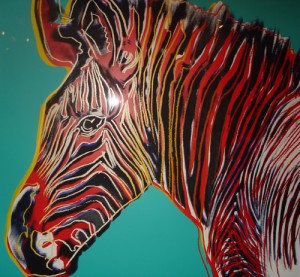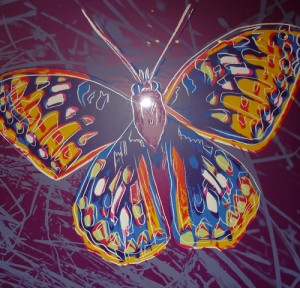 Although Andy Warhol is best known for his Pop Art, but believe it or not he had an interest in nature that began as a child.
Although Andy Warhol is best known for his Pop Art, but believe it or not he had an interest in nature that began as a child.
In his youth, Warhol drew animals in science class, kept a flower garden in the family’s yard, and sketched at local conservatories. In college, he frequented the zoo in Highland Park to draw and study animals.
Warhol’s series of ten silk-screened images of critically endangered animals showcase not only Warhol’s concern for nature, but also his dramatic use of line and color. Warhol’s Endangered Animal series sought to make celebrities out of these wild creatures to bring attention to their plight.
Andy Warhol & Nature
by guest artist/author: Bret McNee
Recently, I visited the National Museum of Wildlife Art in Jackson Hole, WY. It is the only museum dedicated to the wildlife art culture in the United States, so I was pretty excited to see it. The location is fitting, given it boarders the Grand Teton National Park and Yellowstone National Park where wildlife is abundant.
As I was browsing the museum gallery, I came across several works that looked like they had been styled after Andy Warhol. As I looked closer, to my surprise, the paintings were indeed his.

It was really fascinating to see another period Warhol’s work which I did not know existed. Until I saw those pictures, I thought he just did his ‘normal things’: camo screen prints, famous people prints of Marilyn Monroe, John Wayne, Elizabeth Taylor… etc. Warhol’s inspiration for this series was endangered species at that time. I am glad to see the traditional museum could respect his work as something to do with nature, and it was refreshing to see this series was NOT in some pop art museum.
 Warhol is an inspiration for me. I love his originality, his messages, and his attention to color. I think this series says a lot. The images are screen printed, but colored on top of with colored pencil and paints.
Warhol is an inspiration for me. I love his originality, his messages, and his attention to color. I think this series says a lot. The images are screen printed, but colored on top of with colored pencil and paints.
I believe there is a hidden metphor in Warhol’s work: the screen printing symbolizes the man made and the machine… and how we are killing off our natural world’s beauty with our own designs. I think Andy is trying to tell us, in this own way… To simply stop killing our world. www.riotforquiet.com
 Here are some articles you might find interesting:
Here are some articles you might find interesting:
Check out Lori’s art travels
Graffiti: Vandalism or Art?
10 tips to Bring Visitors to Your Open Studio or Art Fair Booth
Learn the Two Biggest Mistakes Artists Make with Social Media
One Simple and Effective Way to Show the World You are a Pro
10 Important Things Every Aspiring Artist Should Know: Part 2
Brand Yourself as an Artist on Twitter
How to “Jump-Start” Your Art Career!
When Are You Ready to Call Yourself a Professional Artist
Do Artists Need Commercial Gallery Representation?
As I was browsing the museum gallery, I came across several works that looked like they had been styled after Andy Warhol. As I looked closer, to my surprise, the paintings were indeed his.

It was really fascinating to see another period Warhol’s work which I did not know existed. Until I saw those pictures, I thought he just did his ‘normal things’: camo screen prints, famous people prints of Marilyn Monroe, John Wayne, Elizabeth Taylor… etc. Warhol’s inspiration for this series was endangered species at that time. I am glad to see the traditional museum could respect his work as something to do with nature, and it was refreshing to see this series was NOT in some pop art museum.
 Warhol is an inspiration for me. I love his originality, his messages, and his attention to color. I think this series says a lot. The images are screen printed, but colored on top of with colored pencil and paints.
Warhol is an inspiration for me. I love his originality, his messages, and his attention to color. I think this series says a lot. The images are screen printed, but colored on top of with colored pencil and paints.I believe there is a hidden metphor in Warhol’s work: the screen printing symbolizes the man made and the machine… and how we are killing off our natural world’s beauty with our own designs. I think Andy is trying to tell us, in this own way… To simply stop killing our world. www.riotforquiet.com
 Here are some articles you might find interesting:
Here are some articles you might find interesting:Check out Lori’s art travels
Graffiti: Vandalism or Art?
10 tips to Bring Visitors to Your Open Studio or Art Fair Booth
Learn the Two Biggest Mistakes Artists Make with Social Media
One Simple and Effective Way to Show the World You are a Pro
10 Important Things Every Aspiring Artist Should Know: Part 2
Brand Yourself as an Artist on Twitter
How to “Jump-Start” Your Art Career!
When Are You Ready to Call Yourself a Professional Artist
Do Artists Need Commercial Gallery Representation?








Thanks for your posts, most interesteing
You are very welcome Amanda!
Lori 🙂
Hi Lori,
A few days ago, I discovered the Andy’s “Endangered Species” collection at a dedicated exhibition in Mons, Belgium. While analysing the paintings, I discovered that the contour lines are gradient in colour.
I’d like to find out what technique he used to achieve this perfect gradient.
Were these contour lines the last layer in his creation process?
If you have any information or tip, I’d be interested.
Thank you in advance.
Cheers,
Ivan
Hello Ivan, I am not sure about Andy’s layering process. I would suggest contacting the museum where his works are on display. The curators will be able to answer that question. I wouldn’t want to steer you the wrong way…thank you for stopping by! ~Lori